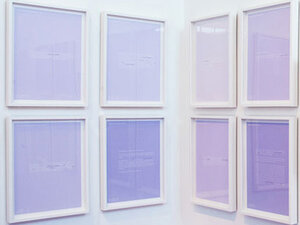Ransick’s L.A. Exhibition Frames Social Issues
State of the Union, a visual arts piece created by Bennington faculty member Robert Ransick is currently on view at Los Angeles Contemporary Exhibitions (LACE) until September 26.

Looking at State of the Union, the viewer is struck by an uncommon blend of the logical with the emotional.
Clean, symmetrical rectangles are shaded with lavender, the color saturating or paling in proportion with numbers, specifically two percentages representing two political positions. The first percentage denotes the number of voters who supported ballot measures that would alter a state's constitution and define marriage as a union between a man and a woman; the second represents those who wanted those measures defeated. The deeper the percentage of lavender, the more gay-friendly the state; in those states where there was overwhelming support for the marriage ban-states such as Alabama and Mississippi-the rectangles become an almost spectral white.
"With this issue, people often act from a place of fear or ignorance, not logic," says Ransick. "I wanted to bring a certain type of beauty to it because, at the core of the issue, we're talking about two people in love. I thought that allowing the numbers, which are logical and can be seen as cold, to drive the palette was a solution that brought these realities together."
State of the Union, which was supported in part by Bennington's faculty grants, consists of 31 prints (of 20 by 15 inches), one for each of the states that have put such ballot measures to their citizens. In addition to the percentages that dictate the palette, Ransick has also included on the prints, in the neutral white typeface known as Humanist, each measure's actual language. Scrawled over that type, however, are handwritten edits made by the artist, reversing the ballot's position. For example, for Alaska, the first state to propose such an amendment in 1998, Ransick takes the sentence – "This measure would amend the Declaration of Rights section of the Alaska constitution to limit marriage" – and scripts the word "expand" over the word "limit."
With a stroke of the pen, the artist rewrites the language created by each state, not merely shifting the perspective of the law and viewer, but by setting his own handwriting against the formal type, demonstrating just how personal such repositioning is. "A man and a woman" becomes "any two people"; Alabama's "sanctity of marriage amendment" becomes its "sanity of marriage amendment"; and marriage's "sacred" covenant instead reads as a "legal" covenant."This is not always the kind of work that gets attention in the art world," says Ransick about work with a political consciousness. "But I deeply believe that art has a role to play in how we understand the world we live in. As an artist, I am continually drawn to topics that I want to understand more fully. Beyond direct methods of civic engagement and action, this is one of the ways I feel empowered in the world: staying informed, making work, and engaging in dialogues about the issues."
Ransick hopes to push the discussion by having the project travel across the country, specifically to the states referenced in the piece. By doing so, the 31 rectangles of State of the Union will be rendered once more, this time in the public squares that served as their inspirations.